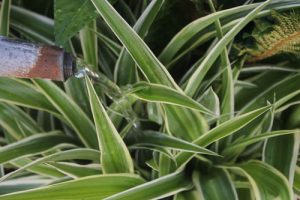Despite the damp dreary weather, you still need to water your hanging baskets and containers as most rainfall runs from the leaves onto the ground around the pot. Petunias and pelargoniums are drought resistant, but if the compost gets dry, under watered fuchsias and lobelia can take weeks to recover. Feed your flowers weekly with high potash fertiliser and dead head daily and don’t forget to check permanent container plants too, regular feeding and watering and a stress free life, will ensure that they remain in good condition, right through the summer.

One downside of moist, humid weather is the appearance of potato blight. Spores are spread by wind and rain and it just loves these conditions. Brown or black patches appear on the tips and margins of leaflets, which curl and wither, it spreads rapidly to the leaves and stems before the whole plant finally collapses and spores are washed down to the tubers. The skin of the tubers then becomes discoloured a reddish-brown rot appears and the potato is gradually reduced to a foetid, liquefied mass.
With no chemical control available, removing infected foliage immediately can slow its spread. Tuber infection can be reduced by ‘earthing up’ or mulching with a thick layer of organic material like hay or straw. Don’t harvest the crop for at least 3 weeks, by which time tubers will have thicker skins and spores on the surface will have died. Lift even the tiniest infected tubers and dispose of them away from the garden and always plant ‘seed’ from reliable sources. Planting alternate rows of different resistant varieties can improve cropping. Grow ‘Sarpo Mira’, the first potato to score 100% in commercial evaluations against blight and its stablemate ‘Sarpo Axona’. Another option is to stop growing main crop potatoes and concentrate on ‘earlies’ which are harvested before early blight makes its unwelcome annual appearance.
Tomatoes are particularly sensitive to changes in their growing conditions. Those in my greenhouse tomatoes have been suffering from leaf curl as a result of fluctuating day and night temperatures, which are always more pronounced in a smaller greenhouse. It is not a major long term problem and it seems to resolve itself later in summers when the temperatures usually stabilise.
It may seem strange during the middle of summer but it is time to look ahead to autumn and winter crops. Make sowings of early vegetables like carrots, peas, turnips, radish and lettuce for harvesting in autumn. Beetroot sown until late in the month, will provide crops for autumn eating and winter storage. Late July sowings of chard should have medium sized leaves by late August, these can be sown in pots – you will only need a few plants of each. Leaf chicory or ‘raddichio’ should be sown in the third week of July for corps that are ready to harvest by October. Control slugs which are the bane of all sowings at this time of year, (though they have made their presence felt already this year). You should be sowing chervil and coriander for later crops, too.
Happy Gardening. Matt










